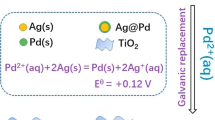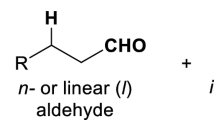Abstract
2-nitroaniline (2-NA) is highly toxic and environmental contaminant. It is reduced to less toxic and environmental benign product o-phenylenediamine by using different reducing agents like sodium borohydride, potassium borohydride, or hydrazine hydrate in the presence of various catalytic systems. These catalytic systems have various advantages and drawbacks. Silica-supported gold nanoparticles are frequently reported catalyst for the reduction of 2-nitroaniline in aqueous medium. In this review article, different catalytic systems reported for reduction of o-nitroaniline under various reaction conditions have been discussed. The critical review of the recent research progress for development of novel catalysts used for the reduction of 2-nitroaniline has been provided here.






Similar content being viewed by others
Abbreviations
- 2-Nitroaniline:
-
2-NA
- o-phenylenediamine:
-
o-PDA
- Sodium borohydride:
-
NaBH4
- Potassium borohydride:
-
KBH4
- Trimethoxysilyl propyl ethylenediamine:
-
TSD
- Iron oxide:
-
Fe3O4
- Nanowires:
-
NW
- Nickel-Tin:
-
Ni-Sn
- Alumina:
-
Al2O3
- Silica:
-
SiO2
- Metal nanoparticles:
-
MNPs
- Hollow silica nanospheres:
-
HSN
- Tetrachloro aurate trihydrate:
-
HAuCl4.3H2O
- Dodecyl trimethoxysilane:
-
DTMS
- 3-aminopropyl triethoxy silane:
-
KH
- Graphene oxide:
-
GO
- Reduced graphene oxide:
-
RGO
- Surface plasmon resonance wavelength:
-
λSPR
- 2-mercapto pyridine:
-
2-MPy
- Polystyrene:
-
PS
- Polyvinyl pyridine:
-
PVP
- Polydopamine:
-
PDA
- N-isopropylacrylamide:
-
NIPAM
- Methacrylic acid:
-
MAA
- Induction time:
-
IT
- Borohydride:
-
BH4 −1
- Glutathione:
-
GS
- Volume phase transition temperature:
-
VPTT
- Cadmium sulfide:
-
CdS
- Ammonium formate:
-
HCOONH4
- Titanium oxide:
-
TiO2
- Polyvinylpyrolidone:
-
PVPL
- Fibrous silica:
-
FS
- Nanoplates:
-
NPl
References
Begum R, Farooqi ZH, Ahmed E, Naseem K, Ashraf S, Sharif A, Rehan R (2016a) Catalytic reduction of 4-nitrophenol using silver nanoparticles-engineered poly (N-isopropylacrylamide-co-acrylamide) hybrid microgels. Appl Organomet Chem. doi:10.1002/aoc.3563
Begum R, Naseem K, Ahmed E, Sharif A, Farooqi ZH (2016b) Simultaneous catalytic reduction of nitroarenes using silver nanoparticles fabricated in poly (N-isopropylacrylamide-acrylic acid-acrylamide) microgels. Colloids Surf A Physicochem Eng Asp 511:17–26
Blakey D, Maus K, Bell R, Bayley J, Douglas GR, Nestmann E (1994) Mutagenic activity of 3 industrial chemicals in a battery of in vitro and in vivo tests. Mutat Res-Gen Tox 320:273–283
Bornick H, Eppinger P, Grischek T, Worch E (2001) Simulation of biological degradation of aromatic amines in river bed sediments. Water Res 35:619–624
Chen P, Lo W, Hu K (1997) Molecular structures of mononitroanilines and their thermal decomposition products. Theor Chim Acta 95:99–112
Dayan S, Arslan F, Ozpozan NK (2015) Ru (II) impregnated Al2O3, Fe3O4, SiO2 and N-coordinate ruthenium (II) arene complexes: multifunctional catalysts in the hydrogenation of nitroarenes and the transfer hydrogenation of aryl ketones. Appl Catal B 164:305–315
Dong Z, Le X, Li X, Zhang W, Dong C, Ma J (2014) Silver nanoparticles immobilized on fibrous nano-silica as highly efficient and recyclable heterogeneous catalyst for reduction of 4-nitrophenol and 2-nitroaniline. Appl Catal B 158:129–135
Du X, He J (2012a) Carrier effect in the synthesis of rattle-type Au@ hollow silica nanospheres by impregnation and thermal decomposition method. Microporous Mesoporous Mater 163:201–210
Du X, He J (2012b) Amino-functionalized silica nanoparticles with center-radially hierarchical mesopores as ideal catalyst carriers. Nanoscale 4:852–859
Du X, Yao L, He J (2012) One-pot fabrication of noble-metal nanoparticles that are encapsulated in hollow silica nanospheres: dual roles of poly (acrylic acid). Chem-Eur J 18:7878–7885
Ezhilarasu D, Murugan E (2012) Synthesis, characterization and catalytic activity of ruthenium and silver immobilized heterogeneous nanoparticle catalysts. J Chem & Cheml Sci 2:61–75
Farooqi ZH, Naseem K, Begum R, Ijaz A (2015) Catalytic reduction of 2-nitroaniline in aqueous medium using silver nanoparticles functionalized polymer microgels. J Inorg Organomet Polym 25:1554–1568
Farooqi ZH, Begum R, Naseem K, Rubab U, Usman M, Khan A, Ijaz A (2016a) Fabrication of silver nanoparticles in pH responsive polymer microgel dispersion for catalytic reduction of nitrobenzene in aqueous medium. Russ J Phys Chem A 90:2600–2608
Farooqi ZH, Ijaz A, Begum R, Naseem K, Usman M, Ajmal M, Saeed U (2016b) Synthesis and characterization of inorganic–organic polymer microgels for catalytic reduction of 4-nitroaniline in aqueous medium. Polym Compos. doi:10.1002/pc.23980
Farooqi ZH, Naseem K, Ijaz A, Begum R (2016c) Engineering of silver nanoparticle fabricated poly (N-isopropylacrylamide-co-acrylic acid) microgels for rapid catalytic reduction of nitrobenzene. J Polym Eng 36:87–96
Gnanaprakasam P, Selvaraju T (2014) Green synthesis of self assembled silver nanowire decorated reduced graphene oxide for efficient nitroarene reduction. RSC Adv 4:24518–24525
Gu H, Wang J, Ji Y, Wang Z, Chen W, Xue G (2013) Facile and controllable fabrication of gold nanoparticles-immobilized hollow silica particles and their high catalytic activity. J Mater Chem A 1:12471–12477
Huang J, Zhang L, Chen B, Ji N, Chen F, Zhang Y, Zhang Z (2010) Nanocomposites of size-controlled gold nanoparticles and graphene oxide: formation and applications in SERS and catalysis. Nanoscale 2:2733–2738
Jado NJ, Sanchez CF, Gomez JO (2004) Electrochemical degradation of nitroaromatic wastes in sulfuric acid solutions: part I. J Appl Electrochem 34:551–556
Junejo Y, Karaoglu E, Baykal A (2013) Cefditorene-mediated synthesis of silver nanoparticles and its catalytic activity. J Inorg Organomet Polym Mater 23:970–975
Khoa NT, Kim SW, Yoo DH, Kim EJ, Hahn SH (2014) Size-dependent work function and catalytic performance of gold nanoparticles decorated graphene oxide sheets. Appl Catal A 469:159–164
Lauwiner M, Rys P, Wissmann J (1998) Reduction of aromatic nitro compounds with hydrazine hydrate in the presence of an iron oxide hydroxide catalyst. I. The reduction of monosubstituted nitrobenzenes with hydrazine hydrate in the presence of ferrihydrite. Appl Catal A 172:141–148
Le X, Dong Z, Zhang W, Li X, Ma J (2014) Fibrous nano-silica containing immobilized Ni@ Au core–shell nanoparticles: a highly active and reusable catalyst for the reduction of 4-nitrophenol and 2-nitroaniline. J Mol Catal A Chem 395:58–65
Lee J, Park JC, Bang JU, Song H (2008) Precise tuning of porosity and surface functionality in Au@ SiO2 nanoreactors for high catalytic efficiency. Chem Mater 20:5839–5844
Li K, Zheng Z, Huang X, Zhao G, Feng J, Zhang J (2009) Equilibrium, kinetic and thermodynamic studies on the adsorption of 2-nitroaniline onto activated carbon prepared from cotton stalk fibre. J Hazard Mater 166:213–220
Lin HL, Sou NL, Huang GG (2015) Single-step preparation of recyclable silver nanoparticle immobilized porous glass filters for the catalytic reduction of nitroarenes. RSC Adv 5:19248–19254
Liu S, Xu YJ (2013) Efficient electrostatic self-assembly of one-dimensional CdS–Au nanocomposites with enhanced photoactivity, not the surface plasmon resonance effect. Nanoscale 5:9330–9339
Liu H, Yang Q (2011) Feasible synthesis of etched gold nanoplates with catalytic activity and SERS properties. CrystEngComm 13:5488–5494
Liu S, Yang MQ, Zhang N, Xu YJ (2014) Nanocomposites of graphene-CdS as photoactive and reusable catalysts for visible-light-induced selective reduction process. J Energy Chem 23:145–155
Meng X, Li B, Ren X, Tan L, Huang Z, Tang F (2013) One-pot gradient solvothermal synthesis of Au–Fe3O4 hybrid nanoparticles for magnetically recyclable catalytic applications. J Mater Chem A 1:10513–10517
Mei MXH (2004) Microwave synthesis in liquid-solid phases for metal complexes of salicylaldehyde with 2-aminoaniline. J Huanggang Norm Univ 6:020
Nalawade P, Mukherjee T, Kapoor S (2013) Green synthesis of gold nanoparticles using glycerol as a reducing agent. Adv Nanopart. doi:10.4236/anp.2013.22014
Pan X, Xu YJ (2014) Efficient thermal-and photocatalyst of Pd nanoparticles on TiO2 achieved by an oxygen vacancies promoted synthesis strategy. ACS Appl Mater Interfaces 6:1879–1886
Pradhan N, Pal A, Pal T (2002) Silver nanoparticle catalyzed reduction of aromatic nitro compounds. Colloids Surf A Physicochem Eng Asp 196:247–257
Rai RK, Mahata A, Mukhopadhyay S, Gupta S, Li PZ, Nguyen KT, Zhao Y, Pathak B, Singh SK (2014) Room-temperature chemoselective reduction of nitro groups using non-noble metal nanocatalysts in water. Inorg Chem 53:2904–2909
Rajesh R, Venkatesan R (2012) Encapsulation of silver nanoparticles into graphite grafted with hyperbranched poly (amidoamine) dendrimer and their catalytic activity towards reduction of nitro aromatics. J Mol Catal A Chem 359:88–96
Rathore PS, Patidar R, Rathore S, Thakore S (2014) Nickel nanoparticles as efficient catalyst for electron transfer reactions. Catal Lett 144:439–446
Ravichandran C, Vasudevan D, Anantharaman P (1992) Electrocatalytic reduction ofo andm-nitroanilines at a Ti/ceramic TiO2 cathode. J Appl Electrochem 22:1192–1196
Razo-Flores E, Donlon B, Lettinga G, Field JA (1997) Biotransformation and biodegradation of N-substituted aromatics in methanogenic granular sludge. FEMS Microbiol Rev 20:525–538
Seo E, Kim J, Hong Y, Kim YS, Lee D, Kim BS (2013) Double hydrophilic block copolymer templated Au nanoparticles with enhanced catalytic activity toward nitroarene reduction. J Phy Chem C 117:11686–11693
Shah M, Guo QX, Fu Y (2015) The colloidal synthesis of unsupported nickel-tin bimetallic nanoparticles with tunable composition that have high activity for the reduction of nitroarenes. Catal Commun 65:85–90
Sharma S (2015) Metal dependent catalytic hydrogenation of nitroarenes over water-soluble glutathione capped metal nanoparticles. J Colloid Interface Sci 441:25–29
Shi L, Yu Q, Mao Y, Huang H, Huang H, Ye Z, Peng X (2012) High catalytic performance of gold nanoparticle–gelatin mesoporous composite thin films. J Mater Chem 22:21117–21124
SonaBae H, HyunaPark K (2011) Hybrid gold nanoparticle-reduced graphene oxide nanosheets as active catalysts for highly efficient reduction of nitroarenes. J Mater Chem 21:15431–15436
Tan L, Chen D, Liu H, Tang F (2010) A silica nanorattle with a mesoporous shell: an ideal nanoreactor for the preparation of tunable gold cores. Adv Mater 22:4885–4889
VanVliet DS, Gillespie P, Scicinski JJ (2005) Rapid one-pot preparation of 2-substituted benzimidazoles from 2-nitroanilines using microwave conditions. Tetrahedron Lett 46:6741–6743
Yang K, Wu W, Jing Q, Zhu L (2008) Aqueous adsorption of aniline, phenol, and their substitutes by multi-walled carbon nanotubes. Environ Sci Technol 42:7931–7936
Yang MQ, Pan X, Zhang N, Xu YJ (2013) A facile one-step way to anchor noble metal (Au, Ag, Pd) nanoparticles on a reduced graphene oxide mat with catalytic activity for selective reduction of nitroaromatic compounds. CrystEngComm 15:6819–6828
Zeng T, Ma YR, Niu HY, Cai YQ (2012) A novel Fe3O4–graphene–Au multifunctional nanocomposite: green synthesis and catalytic application. J Mater Chem 22:18658–18663
Zeng T, Niu HY, Ma YR, Li WH, Cai YQ (2013) In situ growth of gold nanoparticles onto polydopamine-encapsulated magnetic microspheres for catalytic reduction of nitrobenzene. Appl Catal B 134:26–33
Zhang Y, Yuan X, Wang Y, Chen Y (2012) One-pot photochemical synthesis of graphene composites uniformly deposited with silver nanoparticles and their high catalytic activity towards the reduction of 2-nitroaniline. J Mater Chem 22:7245–7251
Zhu CH, Hai ZB, Cui CH, Li HH, Chen JF, Yu SH (2012) In situ controlled synthesis of thermosensitive poly (N-isopropylacrylamide)/Au nanocomposite hydrogels by gamma radiation for catalytic application. Small 8:930–936
Acknowledgements
Authors are thankful to the university of the Punjab, Lahore, Pakistan and Higher Education Commission, Pakistan for financial support under research grant for fiscal year 2015–2016 [Grant Number: D/999/EST.I] and research grant under National Research Program for Universities [No. 20-3995/WRPU/R&D/HEC/14/1212] respectively.
Author information
Authors and Affiliations
Corresponding author
Additional information
Responsible editor: Suresh Pillai
Rights and permissions
About this article
Cite this article
Naseem, K., Begum, R. & Farooqi, Z.H. Catalytic reduction of 2-nitroaniline: a review. Environ Sci Pollut Res 24, 6446–6460 (2017). https://doi.org/10.1007/s11356-016-8317-2
Received:
Accepted:
Published:
Issue Date:
DOI: https://doi.org/10.1007/s11356-016-8317-2




